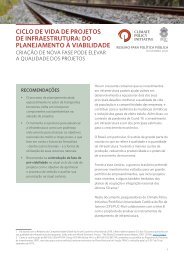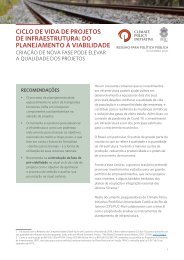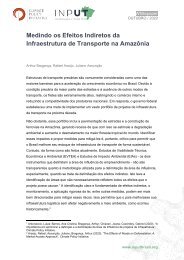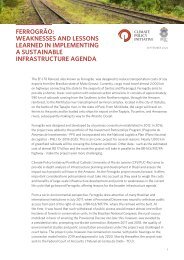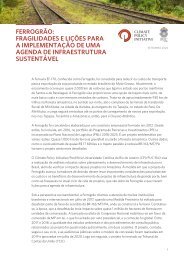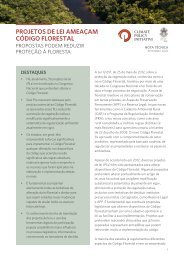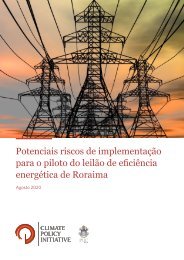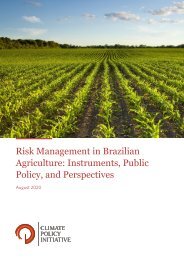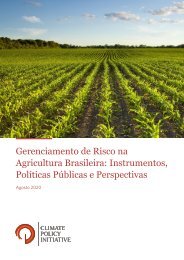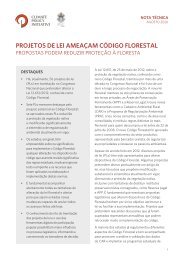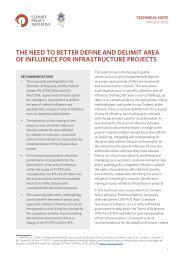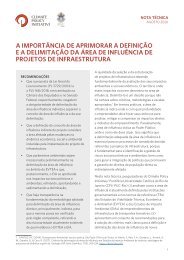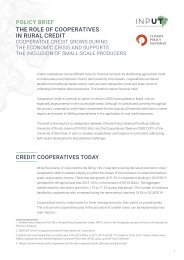Brazil’s Infrastructure Project Life Cycles: from Planning to Viability. Creation of a New Phase May Increase Project Quality
You also want an ePaper? Increase the reach of your titles
YUMPU automatically turns print PDFs into web optimized ePapers that Google loves.
Considering that each plan has its own guidelines (with specific incentive structures and rules)<br />
and project portfolios, the overlap, and lack <strong>of</strong> coordination among them generates uncertainty<br />
regarding the incentives currently in effect.<br />
While none <strong>of</strong> the plans have been expressly revoked, the Federal Government is currently<br />
indicating that the National Logistics Plan (Plano Nacional de Logística – PNL) prepared by the<br />
<strong>Planning</strong> and Logistics Office (Empresa de Planejamen<strong>to</strong> e Logística – EPL) will be the plan <strong>to</strong> guide<br />
the policy on public works and concessions for the land transport sec<strong>to</strong>r.<br />
National Logistics Plan (PNL)<br />
The PNL was published in 2018 by the EPL with a time horizon up <strong>to</strong> 2025. A new PNL is<br />
expected with a time horizon <strong>of</strong> 2035. The plan reviews the guidelines <strong>of</strong> the National Transport<br />
Plan and other plans in the logistics sec<strong>to</strong>r, such as the National Waterway Integration Plan<br />
(Plano Nacional de Integração Hidroviária – PNIH) and the National Port Logistics Plan (Plano<br />
Nacional de Logística Portuária – PNLP). 20<br />
The goal <strong>of</strong> the PNL is <strong>to</strong> strike a balance among transport modalities, considering the relative<br />
efficiency <strong>of</strong> each one. Secondary objectives aim <strong>to</strong> lower carbon dioxide (CO 2<br />
) emissions and<br />
reduce cargo transportation costs.<br />
The PNL’s planning exercise was meant <strong>to</strong> pinpoint “bottlenecks” (i.e., markets where the supply<br />
<strong>of</strong> transport infrastructure fails <strong>to</strong> meet demand) by comparing the current scenario 21 <strong>to</strong> an<br />
optimized scenario (“2025 Scenario”) and using priority projects in the road, rail, and waterway<br />
sec<strong>to</strong>rs as a reference. A <strong>to</strong>tal <strong>of</strong> 40 projects were included in the PNL (31 road, eight rail, and<br />
one waterway project). 22 To be included in the PNL, projects had <strong>to</strong> have been on the agenda for<br />
execution when the plan was drawn up, and scheduled <strong>to</strong> be up and running by 2025.<br />
Based on these criteria, the following projects were considered: qualified projects under the<br />
Investment Partnerships Program (Programa de Parcerias de Investimen<strong>to</strong> – PPI), components <strong>of</strong><br />
the Avançar Program, current concession obligations, and capacity expansions in concessions<br />
subject <strong>to</strong> potential term extensions. The plan did not explicitly feature any socio-environmental<br />
criteria for project inclusion. It merely points out the possible impacts on CO 2<br />
emissions if the<br />
optimized scenario comes <strong>to</strong> pass. 23<br />
The EPL is currently preparing an update <strong>to</strong> the PNL, known as the 2035 PNL, which is expected<br />
<strong>to</strong> feature a chapter devoted <strong>to</strong> the socio-environmental components <strong>of</strong> infrastructure projects.<br />
As <strong>of</strong> yet, however, no announcement has been made about which components will be listed or<br />
the weights assigned <strong>to</strong> them in project selection as part <strong>of</strong> the sec<strong>to</strong>ral planning process.<br />
20 The drafting process for the PNL <strong>to</strong>ok in<strong>to</strong> consideration existing sec<strong>to</strong>ral plans tied <strong>to</strong> federal and state governments. In addition <strong>to</strong> the PNIH and<br />
PNLP, other references were: the PNLT; PHE; PELTs; and PNLI.<br />
21 The current scenario includes the main works in progress plus the ones that were expected <strong>to</strong> be completed by the end <strong>of</strong> 2018.<br />
22 Annex 1 includes the list <strong>of</strong> the projects included in the PNL. Furthermore, in addition <strong>to</strong> the projects considered under the “2025 Scenario”, a<br />
<strong>Project</strong> Portfolio was proposed with other strategic undertakings <strong>to</strong> resolve the remaining bottlenecks (especially in the road sec<strong>to</strong>r), since many<br />
<strong>of</strong> the initial bottlenecks were mitigated by increasing the supply <strong>of</strong> railroad transportation. As such, the Portfolio also included 23 other projects,<br />
including 19 focused on adapting road sections, two on highway construction, and two on railroad construction.<br />
23 The document also states that the new version <strong>of</strong> the PNL will include a cost-benefit analysis involving PAE and a socio-economic impact<br />
assessment. The PAE proposal is under development by the EPL and seeks <strong>to</strong> change the way the environmental variable fits in<strong>to</strong> strategic<br />
infrastructure planning, while taking the concept <strong>of</strong> AAE in<strong>to</strong> account. It also seeks <strong>to</strong> inform decision making on priority investments and provide<br />
additional legal, economic and technical security <strong>to</strong> project development in the realm <strong>of</strong> transport.<br />
6



